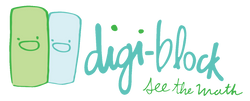

The Decimal Point: How a 7-year-old Invented Something Better


The decimal point baffles many children. They often don’t know what it’s for and what the numbers that follow it represent. It doesn’t have to be this way! The best success I’ve had teaching the decimal point has come from guiding my students to essentially inventing it themselves.
When we’re first teaching kids numbers, we’re only concerned with whole numbers (1, 2, 3, 4, etc.) so we can simply say that the number, or digit, that’s furthest to the right corresponds to the ones, which with Digi-Block is the smallest block. But what if we want to be able to express numbers that aren’t whole numbers, such as 20.75? Or 0.3? I can introduce the decimal blocks, but now there is no longer a “smallest” block, because the blocks could in theory always get smaller and smaller, so we can no longer use the simple rule that “the smallest block is the number at the right end.” We need something new!
The way I teach explores these ideas and shows the need for a new device for writing numbers. This engages and excites students. They might come up with a solution that works. Even if they don’t, they’ll now appreciate the solution and have a deeper understanding of why we’ve introduced something new.
First, you need to explore the idea that there’s stuff out there smaller than 1, but bigger than 0. When I teach with Digi-Block blocks, I ask kids, what do I find if I open up a block-of-10? They quickly respond, “10 ones!” I then hold up a one, or single, and ask, what do you think I’d find if I could open this block up too? They think about it and say, “10 smaller blocks inside?” And I say, “Yes, you’re right!” And then I show them the tenths blocks.
Start by writing a multi digit number down, such has “572”. Ask your student to read you the number. Ask him “How do you know which digit is the hundreds? Which digit is the tens? Which digit is the ones?” This question might leave him staring blankly back at you or you might have an interesting discussion about place value.
Regardless, the next step is to open up your student’s thinking. You’ll use different color ink for each power of ten. The idea here is that we can use color, not position, to determine the value of each digit. Tell him “I’m going to use purple for hundreds, blue for tens, and green for ones.” Now write the same digits on a piece of paper, but use green for the “2,” purple for the “5,” and blue for the “7.” Now ask your student to read you this number. If he deciphers the code correctly, he should realize it’s the same number as before: 572! Try a few more examples until he gets the hang of it.

Now ask him if he can think of a different way, maybe without color. I had one student who wrote numbers in different sizes to represent powers of ten. It looked like this:

As he tried to write more and more numbers, and longer numbers that required more than 3 digits, he decided this wasn’t very practical.
I then presented him with our problem: we have things smaller than 1. I bring the tenths blocks back out to show him what I mean. (It’s not important to name these yet, you’re just using them to show a unit smaller than the singles.)
I put out several blocks (a few hundreds, tens, ones, and tenths) and said, how do I write this down? I then took them away and said, or if you write a number down for me, a number that should use those little blocks (the tenths blocks), how will I know what to build?
After some time to think about it. I came back to the “572” we had written before. I asked which way do the digits mean bigger blocks? Which way do they mean smaller blocks? He quickly saw that the digits to the left were for larger blocks and the digits to the right were for smaller blocks. He jumped up and said that the digit for the smaller block must to the right of the one!
He wrote a 4 digit number down, “4823,” but realized it looked like four thousand eight hundred twenty three.
I asked him, what can we do to let me know which digit is for which size block? (Like how we used color before…)
He thought about it and then showed me his idea: he would circle the digit in the ones place. I thought this was fantastic! After some more thinking, I think this is actually better than the decimal point.

Circling the digit in the one’s place shows the relationship between the digits to the left and to the right of the one’s place much more clearly. Ten is one power of ten greater than 1, and one tenth is one power of ten less than 1. 100 is two powers of ten greater than 1 and one hundredth is two powers of ten less than 1, and so on. The decimal point obscures this and makes it look like the relationship between 1 and one tenth, 10 and one hundredth, and so on, should be emphasized…
Back to my student! I told him I thought his idea was great, but a long time ago, when people had to solve this problem, they came up with something a little different: the decimal point. I showed him how to write a number with a decimal point and then asked him to build it in blocks.

0 comments